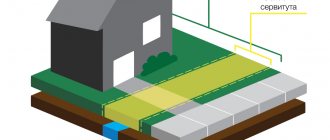Before purchasing a land plot, it is imperative to check its legal purity, since situations often arise when there is a ban on registration actions.
Dear readers! The article talks about typical ways to resolve legal issues, but each case is individual. If you want to find out how to solve your particular problem , contact a consultant:
8 (800) 700 95 53
APPLICATIONS AND CALLS ARE ACCEPTED 24/7 and 7 days a week.
It's fast and FREE !
Such phenomena are designated by the term – encumbrance. Moreover, in many cases it will be simply impossible to remove it even through the courts.
That is why, before signing a purchase and sale agreement or another confirming the transfer of ownership rights, it is worth making sure that the site is clean. This can be done via the Internet, through special websites, or by creating a special request.
Moreover, this process has many different nuances and subtleties. As a rule, the land plot itself must be registered accordingly.
Otherwise, information about it may simply not be available in Rosreestr. It is this database that is used to obtain all the information necessary in this case.
What it is
Land plots can be transferred to citizens and legal entities for ownership, as well as for temporary or indefinite use.
In each of these cases, the owners have a legal right to use the land for its intended purpose (for example, agricultural land can only be used for growing agricultural products or other similar purposes). Restrictions on the rights of owners or possessors are permitted only in cases provided for by law or based on the terms of contracts. Legislative acts allow the following forms of encumbrances on land:
- prohibitions and restrictions established in regulations and targeted restrictions on certain areas of land use (for example, a ban on constructing industrial and production facilities on lands allocated for personal farming);
- restrictions associated with the emergence of a public or private easement, i.e. the ability of third parties to use someone else's land plot;
- prohibitions and restrictions related to the emergence of legal claims - arrest to secure a claim or to ensure enforcement actions;
- restrictions on the ownership and disposal of land that arise with the consent of the copyright holder (for example, a mortgage when purchasing land on credit);
- temporary restrictions associated with the conclusion of a lease agreement (when transferring ownership of land, lease relations are maintained for the entire duration of the agreement).
Thus, various types of restrictions can arise directly by force of law, under the terms of contracts and agreements, as well as on the basis of judicial acts.
Based on the analysis of the norms of the Land Code of the Russian Federation and the Civil Code of the Russian Federation, we can distinguish the following types of encumbrances that can be established on land plots:
- public and private easements;
- mortgage encumbrance;
- a lease agreement whose term exceeds one year;
- arrest imposed by a judicial act or resolution of an official of the FSSP;
- trust management;
- concession.
In some cases, a prohibition or encumbrance may arise based on the special status of the property located on the site. For example, a historical heritage site automatically imposes restrictions on the corresponding land area.
How do land encumbrances arise?
Imposition of an encumbrance on a land plot is possible only in cases specified by law. An analysis of the legislation allows us to identify three possible grounds:
- Agreement. According to it, the owner voluntarily limits his property rights or transfers them to another party, for example, under a lease agreement.
- Act of the authorized body. In cases established by law, state and other bodies can limit the property rights of owners: a court decision, a village council, a bailiff's decision.
- Law or by-law. State regulations and decisions of local governments establish some restrictions on the right to use land: a ban on construction on agricultural territories, etc.
Such grounds are firmly connected with the nature of the restrictions - a specific reason is provided for each type of encumbrance. For example, you cannot seize land by concluding an agreement, or encumber land with a lease by court decision.
Some forms of restrictions may arise for several reasons.
The Land Code is what guides us in this case. Its article 11.8 talks about how encumbrances arise:
- Paragraph 2 of this article stipulates the rights to unlimited and free use of plots.
- clause 4 defines the lease relationship and its contractual terms.
- the fifth paragraph establishes the boundaries of easements within the site.
How to sell an apartment encumbered with a mortgage? The answer is contained in the article at the link.
A sample certificate of state registration of land rights with information about encumbrances.
Encumbrance of a land plot is a restriction that is imposed on the basis of:
- appropriate law or by-law;
- contract (for example, in the case of a long-term lease or mortgage)
- court decision (for example, arrest or public easement).
How to find out
Why is it necessary to know information about established restrictions and encumbrances on land? The fact is that any registered encumbrance significantly limits the right of the owner or possessor to freely dispose of the plot, and in some cases, the exclusive right of use. Here's what the established encumbrance can affect:
- the owner is deprived of the opportunity to sell the land plot or rent it out for temporary use to other persons (if a mortgage is registered on the plot, the sale of the land is possible only with the consent of the mortgagee);
- under the terms of the easement, the owner or tenant of the land is forced to sell the plot while maintaining the legal regime of the specified encumbrance (the easement will remain in force until its expiration);
- during the duration of the encumbrance, the right holder may be completely or partially deprived of the opportunity to use the plot for its intended purpose (for example, when transferring land for lease, the owner does not have the right to use the plot, since this right is transferred to the tenant on a reimbursable basis).
Any encumbrance will come into force only from the moment of registration with the Rosreestr service. This procedure may be part of a civil transaction (for example, if a pledge is established when drawing up a purchase and sale agreement), or during an independent application (for example, when concluding an agreement on a private easement). During the registration process, data on encumbrances is entered into the state register of the Unified State Register of Real Estate, information from which is available to all interested parties.
Any citizen or legal entity can obtain information from the USRN state register about the presence of registered encumbrances. To do this, you need to send a request in one of the following ways:
- directly to the territorial office of Rosreestr;
- through the system of Multifunctional Centers;
- in electronic form through the official government services portal.
When applying in this way, the interested person must indicate in the request the cadastral number of the plot or the address of its location. Similarly, when applying through the public services portal, the cadastral number or address of the plot must be indicated in the search form (you can also select the plot of interest through a graphic map of the country).
Information about registered encumbrances is available to any interested party, which is an additional way to verify the legal purity of the transaction. Even if the encumbrance does not prevent the disposal of land, it will significantly affect the market value of the land property (for example, the sale of an object with a registered easement will significantly reduce the attractiveness of the site in the eyes of buyers).
Upon request to the Rosreestr service or the Multifunctional Center, the applicant will receive an extract from the Unified State Register. This document will contain a list of basic information on the selected site, including the form and type of encumbrance. Since the USRN database is updated in real time, to minimize risks when making transactions, the extract must be taken directly when executing the contract.
Property information
The legislation does not have a clear answer to what an encumbrance on a land plot is.
This concept was contained in the already abolished Art. 1 Federal Law No. 122 dated July 21, 1997. It followed from the law that encumbrances should be considered conditions and prohibitions that limit the right holder in the exercise of ownership and other proprietary rights to real estate: disposal, possession, use. Although the normative act has lost force, the definition established by it is still relevant. Its analysis allows us to understand the essence of the phenomenon and characteristics:
- An encumbrance is a restriction that restricts certain rights of the land owner.
- It is intended to protect the subjective rights of third parties in whose favor it is established: creditor, tenant, mortgagee.
- The encumbrance is not associated with the deprivation of the owner of his rights, since, as a rule, it is temporary.
To understand what an encumbrance on a garden plot means, it is important to understand what specific allotment we are talking about. The current legislation contains about a dozen restrictions. Each of them has a unique meaning: some are a measure of responsibility/coercion, others are a form of securing obligations, and others are property-obligatory legal relations of owners and third parties.
Moreover, all of them can arise only for a limited number of reasons.
Previously, the information that a citizen could obtain online was not always reliable. There are a lot of reasons for this, but one of the main ones was that current data was entered into the database quite rarely. It is not uncommon for indignant owners to discover information that their property is under a mortgage or pledge, but in fact it turns out that they relied on irrelevant information obtained on the Rosreestr website.
Since the beginning of 2020, a reform has been carried out affecting registration of real estate and its accounting itself. It was decided to combine the cadastral register and Rosreestr into a single database, which will reflect all information about real estate and civil rights regarding it. Thanks to the merger, not only were inconsistencies eliminated, but also a transition was made to digital data storage, which will make it possible to obtain property information anytime, anywhere.
Previously, it was possible to find out about the presence of encumbrances on a specific piece of real estate by receiving an extract from the Unified State Register, but today this procedure has changed. You can order USRN information in any convenient form. To do this, you will need to visit the official website of Rosreestr and try to get information from the help desk. To clarify encumbrances on a land plot by cadastral number, you should adhere to the following algorithm:
- Select the “Services” tab on the main page of the official website of Rosreestr;
- Then select “Reference information about the property online”;
- You will see a form in which you must provide information about the property. If you have the cadastral number of the object at your disposal, it is not necessary to indicate other data, since the code is strictly individual;
- If information about the owner of the property is available, the encumbrances with which the property is encumbered must also be indicated.
Thus, if you have a cadastral number, you will be able to obtain the information you are interested in about the property. However, it is worth considering that the data here may not be complete. If you are interested in more detailed information, or the reference book does not contain data on the property you are interested in, you should order information directly from the Unified State Register of Real Estate.
How to remove an encumbrance
As long as an encumbrance is recorded on the plot, the ability to dispose of the land will be significantly limited. For this reason, every owner of a plot of land is interested in removing the encumbrance and canceling the entry in the state register of the Unified State Register of Real Estate about its registration. Based on the legal regime of various types of encumbrances, their removal can occur as follows:
- as a result of the repeal of a legislative or administrative act by which the restriction was introduced (for example, the protective category of land established by a government decree can be changed by canceling the said act);
- termination of an agreement on a private easement or other type of restrictions on land;
- the expiration of the period for which the encumbrance was registered (for example, if the term of the easement or lease agreement has expired);
- full fulfillment of the obligation for which the encumbrance was registered (for example, full payment under a mortgage loan agreement);
- issuance of a judicial act that cancels the encumbrance.
The simplest and most obvious option for removing the encumbrance is the expiration of its validity period or the conclusion of an agreement. In particular, if there is a private easement on the site, its parties have the right to terminate the agreement at any time or apply for the cancellation of a judicial act. The law does not require any special grounds for this; it is enough for the parties to express their free will.
Forced cancellation of an easement and annulment of the corresponding encumbrance is possible in the following cases:
- non-compliance with the terms of the established easement - violation of the procedure and terms for transferring payment to the owner, obstacles to the free use of the rest of the allotment, etc.;
- violation of legislative norms when introducing an easement when issuing administrative acts;
- eliminating the grounds for preserving the easement (for example, moving linear structures outside the site).
To remove and annul an easement in the listed cases, the copyright holder must apply to the courts. Cancellation of an entry in the USRN state register will occur on the basis of a submitted judicial act.
If the land owner has fully paid off the mortgage, in order to remove the encumbrance, he must submit a payment order and a bank statement about the repayment of the debt to the Rosreestr service. In this case, the cancellation of the entry in the Unified State Register will be carried out on the basis of a unilateral application from the copyright holder of the site.
If the encumbrance was established on the basis of a judicial act or a resolution of an official of the FSSP, it can be removed in the following ways:
- if the arrest is imposed as an interim measure during the consideration of the claim, after the positive completion of the process it will be lifted automatically;
- in order to cancel the arrest, you can offer the court or bailiffs another object of equal value (for example, an apartment);
- The arrest can be lifted if procedural rules were violated when it was imposed (for example, if a bailiff’s decision was made in relation to someone else’s land plot or if there is shared ownership of several citizens).
The cancellation of a court decision or a bailiff's act must be confirmed in the state register of the Unified State Register of Real Estate. To do this, the copyright holder submits a corresponding application to the Rosreestr service and indicates the reasons for removing the encumbrance. From the moment the data is entered into the state register of the Unified State Register, the owner again has a full right to dispose of his allotment.
The concept of land encumbrance
To understand the peculiarities of the relationship associated with the encumbrance of land, the possibilities of its application and removal, you first need to understand what it is.
A similar term has been known for quite a long time, both in domestic and foreign law. In simple terms, an encumbrance, depending on the grounds for its occurrence, is often identified with a restriction (some restriction) of the property right of the owner of the allotment (for example, disposal or use), or is understood as the impossibility of using the entire allotment if a land easement is established, while the right to alienate and transfer the plot to other persons is not limited.
So, the burden can be expressed in the following :
- the inability to dispose of the allotment and alienate it through both compensated and gratuitous transactions;
- prohibition on the placement of certain objects. For example, you cannot build a residential building on industrial land;
- imposing an obligation to provide temporary rights of use to third parties (easement).
Any restriction is the result of either a voluntary agreement or a direct indication of legal norms (judicial and other legal acts). For example, the use of an easement is possible without an agreement, through the court.
Bases and methods of application
Encumbrances can be imposed on a plot based on:
- a legislative act establishing restrictions on the exploitation of land of the specified category;
- contractual relations between the owner and a third party (for example, long-term rent or mortgage>);
- court decision (for example, establishing an easement or seizure).
How to register an encumbrance
Registration of encumbrance is carried out only through Rosreestr (you can submit documents to the MFC). You will need to provide the document on the basis of which the ban was imposed, for example, a mortgage agreement, as well as other documents, the list of which depends on the type of restriction and the situation.
Who superimposes
Burdensome measures, regardless of the basis, have the right to be imposed by several subjects of relations:
- state or municipal authorities, if the establishment of an operation is necessary to achieve specific interests at different levels. Committed when it is impossible to resolve the conflict in the usual way;
- judicial authority. Then the encumbrance is imposed for incorrect use of the property. In this case, for inappropriate use. It is also possible if there are no other ways to reach the required agreement;
- upon reaching agreement between the parties to the transaction on adjacent land plots, which leads to the conclusion of a concession or easement agreement. This is often carried out between the legal entity and the individual who provided financial assistance in the acquisition.
Other methods are considered a violation of the owner’s rights and contradict current legal acts.
Land encumbrances and how to remove them
Buying land is always a significant event. The land plot itself already implies plans for its development. Whether it is the construction of a residential building or a certain enterprise, everyone who wants to purchase a plot has their own specific goals. But how can you protect yourself while shopping?
This is interesting: They call you to the military registration and enlistment office to clarify the data: should you be afraid?
If you come across a suitable plot of land for sale, especially at a low price, under no circumstances should you rush into purchasing it! First of all, it is necessary to check this land for encumbrances, because if they are present, you may lose not only the opportunity to realize your goals, but even the site itself. What are encumbrances, what they are like and how to get rid of them - further in our article.
Is it possible to rent out an apartment with an encumbrance?
In most cases, even if an encumbrance is placed on the apartment, the owner can use it as an additional source of income and rent it out. For example, you can rent out an apartment that is used as collateral for a mortgage, if the loan agreement does not specify the condition - rent with the consent of the mortgagee. An exceptional encumbrance can be a court decision by which the owner temporarily loses not only the right to dispose of, but also the right to use the property.
What is an encumbrance?
Encumbrance of a land plot is the restrictions that are imposed on its possible use by the owner (arrest, easement, lease). These restrictions remain even if the owner of the plot changes through alienation through purchase and sale, donation or inheritance. It is for this reason that it is necessary to check their availability before making a transaction.
The restriction that is imposed on a site may be related both to the site itself and to what is located on it. The second applies to protected sites, including architectural monuments. In addition to state-protected objects, this may be due to the activities of the previous owner and his debts for one reason or another.
There may be cases of not one, but even several sales of a plot from which the encumbrances have not been removed. Moreover, the reluctance to remove them from the land plot may be one of the main reasons for the sale. Since all encumbrances are noted by Rosreestr, you can request information in advance from the Unified State Register of Real Estate (USRN) before purchasing. This procedure is a necessary part of a secure transaction.
Removing encumbrances from an apartment or house
Definition of encumbrance. Housing that has some restrictions is considered encumbered by law. These facts are primarily related to the fact that there is no possibility of free disposal of property until third parties give their consent. Property cannot be transferred as an inheritance object or sold. In this regard, the process of selling encumbered apartment property is complex and needs amendments. But, nevertheless, buyers are eager to purchase it because of its low cost, which is no less than 50% of the market price.
What are they?
If we do not take into account those encumbrances that are directly related to the protection of specific cultural objects, then most often six different types of encumbrance on a land plot are considered. Each should be studied separately, taking into account the different requirements and circumstances for imposition.
Long term rental
A long-term lease agreement can be concluded for a land plot - from one year to a very long period. Such an agreement is not an obstacle to sale and inheritance , and the sale does not terminate the agreement. After the transaction is completed, the new owner will simply find another person on his property. An unexpected acquaintance with a tenant will not be the most pleasant outcome of purchasing a plot you like.
If you find yourself in such a situation, you need to read the contract in detail and study all the clauses in the presence or with the help of a qualified lawyer.
Mortgage
Unlike standard mortgage agreements for the purchase of an apartment or house, land plots have their own characteristics:
- It is possible to purchase not only ownership rights, but also a long-term lease agreement with a mortgage. In such transactions, the consent of the owner is required;
- The size of the plot should not be less than the established norm for land use;
- It is impossible to issue a mortgage agreement on land plots that are owned by the state and the municipality. However, an exception may be a plot that is specifically intended for the construction of a residential building. Unless, of course, the mortgage agreement specifies the purchase for the purpose of building housing or improving it.
Easement
An easement is a limited right of use in relation to someone else's land plot. It is acquired along with the acquisition of a specific land plot, and this limited use can be expressed in:
- The right to lay communications, water supply and other necessary channels to provide your own site with gas, electricity, electricity, water supply, sewerage, etc.;
- The right of passage or passage through the site;
- The right to use for the purpose of land reclamation.
Moreover, an easement can be either for one specific person, the owner of the site (private easement), or in relation to several owners (public easement). With a public easement, an unlimited number of people have the right to cross the site, mow hay there, drive cattle, etc.
The adoption of a public easement is carried out exclusively with the help of a regulatory act issued by local or federal authorities. The imposition of private property can be made either through a separate agreement or by a court decision in the event of a conflict.
Concession
A concession is a restriction on the use of buildings or structures, and in some cases, land. According to this restriction, fixed by the agreement, the owner or lessee of the site transfers the right of use only for the purpose of making a profit to the concessionaire.
If we consider a plot of land, then such a profit may be the extraction of any minerals, as well as the use of other resources located on the plot. In addition, structures for commercial activities can be erected.
Trust management
Trust management is the transfer of property to another person under a trust management agreement for an indefinite period. The person to whom this management is given is obliged to manage the entrusted property, adhering to the interests of the founder (trustor) or beneficiary.
This type of restriction is also included in the Rosreestr data, so you can always request information on the trust management of a specific plot and receive it.
Arrest
This type of land encumbrance is the most common. As a rule, arrest is associated with the presence of any debts, and its imposition is carried out in accordance with a writ of execution issued by the court. Such a restriction prohibits the sale, alienation of property, as well as leasing it. According to the law, any transactions with a land plot during arrest are illegal. That is, if there is a seizure on a land plot, it simply will not be possible to register it or otherwise conclude contracts. Rosreestr will simply refuse to confirm the deal.
In addition to the ban on transactions, the arrest also imposes restrictions on the division, re-registration of the resulting plots, increasing its size, merging with a neighboring plot, regardless of the ownership rights of another plot. No operations with this land plot can be carried out exactly until the arrest is lifted.
Legal concept of encumbered property
As you know, maternity capital funds are not given to parents. Transfers are made immediately to the seller or lender who issued the money for the purchase of real estate. However, the apartment must already be registered as the property of the applicant.
Attention. For many families, when using maternity capital, the most popular option is to take out a mortgage. In this case, restrictions are officially imposed on housing.
Thus, the legal concept of encumbrance with a mortgage is indicated in Article 11 of the Federal Law of the Russian Federation “On mortgage (mortgage of real estate)”.
In this case, the purchased apartment is limited by the rights of the bank. This means that its owner (borrower) does not have the right to make any transactions in relation to it (sale, exchange, gift, etc.) until the debt is fully repaid. Any legally significant action must be agreed upon with the creditor.
The fact of imposing a mortgage encumbrance on real estate must undergo the state registration procedure.
In this case, a corresponding entry is made in the Unified State Register, which must be repaid in the same way after the loan is repaid.
You may be interested in the following articles:
- Is it possible to sell an apartment with a mortgage encumbrance? Main nuances of the procedure
- What is the sale of an apartment with an encumbrance in favor of the seller?
- Is an apartment purchased with maternity capital divided during a divorce? How does this process happen?
- Features and nuances of drawing up a contract for the sale and purchase of an apartment using maternity capital
- Drawing up a contract for the sale and purchase of a share in an apartment with maternity capital. Sample agreement and transaction details
Limitations in practice
Let us consider the types of real estate encumbrance in more detail. In all of the above cases, the owner of the property continues to manage it – that is, the property “works”. He can rent out his office, store or warehouse or work there independently.
1. If the property is leased, this does not interfere with the sale. But the law protects bona fide tenants: the new owner of a building or store automatically becomes the current landlord and cannot ask to “leave the property” if the lease agreement is not subject to early termination. When we are talking about a period of several years, this can become a significant problem.
2. Trust management is the transfer of property to the disposal of a trustee, who does not become the owner of the property. Most often used in the bankruptcy of an individual or legal entity, as well as in the interests of heirs and minors under guardianship.
3. Pledge and mortgage imply preliminary repayment of obligations to the bank. Moreover, both the debt and the interest on it.
4. Arrest is a serious burden. Seizure is imposed by bailiffs by court decision in the interests of creditors. Legal disputes are not always directly related to the object - the owner may be in debt to the bank or third parties, and the arrest has a security nature and is imposed on liquid real estate.
5. A ban on registration actions means that a transaction cannot be registered until the resolution is cancelled. As in the previous case, any transaction regarding the object (including barter and donation) will be considered void. This threatens the owner with fraud charges.
6. Easements are a rare occurrence in commercial real estate. More often associated with the conditions of use of the land plot rather than with the building itself. For example, when there is a residential building nearby, the owner can only get to it through the territory of another property.
Features of transactions with encumbered real estate
Even if an encumbrance is imposed on a house or other object, the current legislation provides for a method for its implementation. In most cases, the key reason for a forced sale is the loss of solvency of the mortgage recipient. Of course, you can let things take their course and wait until the bank independently finds a buyer and sells the property. However, in this case, the interests of the seller are in last place, since it is profitable for the bank to sell the collateral property as soon as possible and cover losses.
To independently sell an encumbered apartment, several conditions must be met:
- Obtain consent to the transaction from the credit company that imposed the encumbrance;
- Notify the potential buyer of the existence of relevant restrictions;
- Determine the cost of housing.
The established amount must be equal to or exceed the remaining balance of the mortgage. The seller's interest and benefit depend entirely on the price of the apartment. In fact, he will only receive the funds that remain after repaying the mortgage debt.
If all of the above conditions are met, the banking organization will lift the restrictions and the purchase and sale transaction can be completed. An agreement is signed between the parties to the transaction, which is subject to mandatory registration with Rosreestr. This approach will allow the seller to legally sell the apartment, and the buyer to purchase housing that is guaranteed to be free of encumbrances.
As practice shows, such a transaction is quite profitable for the buyer. This is due to the fact that the price of encumbered apartments is significantly lower than the cost of “clean” real estate.
How to recognize the presence of an encumbrance
It is great when the buyer enters into a transaction absolutely consciously, and he has information that the home he is purchasing has an encumbrance. But practice most often shows situations in which the owner deliberately conceals this fact in order to sell the property as profitably as possible. Therefore, every citizen who wants to honestly take possession of housing needs additional reinsurance related to the exclusion of the fact of encumbrance. This can be done simply. It is necessary to submit the required application to a specialized authority, having previously paid the fee. After entering it into the state treasury, you will become the owner of complete information about your object. In the document that will be handed to you, in the 4th paragraph, information regarding the encumbrance will be indicated. If the “not registered” fact specified in this paragraph is present, you can confidently make a transaction, especially if all other nuances and factors do not bother you.
If, at the end of the transaction, information is received about the existence of an encumbrance, this is not a reason to panic. According to legal norms, the new owner of the apartment is not responsible for the debts of the previous owner, these are his problems. However, the situation is aggravated by the fact that you will have to constantly go to court. Before the money is handed over to the seller, there is no need to be lazy, but it is important to thoroughly check the property.
So, we looked at how to remove an encumbrance from real estate, and it can be noted that this is easy to do. If you have doubts about your own competence on this issue, you should contact a qualified lawyer. If you take this task seriously and follow the advice of professionals, then the end result will definitely bring you the joy of owning a home unencumbered by any circumstances.
How to remove the encumbrance?
If we talk about the restrictions under which the transfer of ownership of a land plot is possible, then everything will depend directly on the current agreement. When faced with encumbrances, you will need the help of a qualified lawyer, because each case must be considered individually. Of course, the most favorable option would be a preliminary check to avoid such difficulties.
However, if you nevertheless purchased a plot of land with encumbrances, then you need to:
- Carefully study the documentation on the legal relationship between the owner, who is now you, and the other party;
- Request complete information about this land plot from Rosreestr;
- Consult a lawyer regarding the information available.
On our website you can get legal advice completely free of charge. If you want to solve problems with the encumbrance of a land plot, assess the possible benefits and risks associated with its acquisition, and generally navigate your actions, then our specialists are ready to help you right now. You can also order a call at a time convenient for you. And remember - good legal support is almost a guarantee of success.
Graduated with honors from the Faculty of Law. Since 2006, she has specialized in controversial issues related to inheritance and donation.
What is this?
Encumbrance on a plot is an action aimed at reducing the freedom to dispose of land. The Land Code regulates the owner’s capabilities and determines the situations when an encumbrance arises. The municipality supplements the law with local acts. When is land considered encumbered? Under the following conditions:
- Easement: An interested group or person has access to land, which includes the right of way or installation of power lines, pipes. There is a distinction between private and public subordination. Is temporary or permanent.
- Mortgage: the owner took out a loan, and in return mortgaged the land to the bank. Transactions with it must be approved by the bank, since the property is theirs for the duration of the loan payments.
- Rent exceeding 12 months. Long-term contracts are subject to registration with Rosreestr. It is permitted to sell the property, but any lease obligations entered into will pass to the buyer.
- Seizure of land. Most often, conscription arises as a result of debts. The plot is sold and the owner's minus is paid off with the proceeds.
- Historical value: arises when an architectural monument is located on the site.
This is interesting: What is loan restructuring in a bank? The essence of loan debt restructuring
Any of the restrictions are subject to official recording in the Registrar's Office. The register is available to any citizen of the Russian Federation. Since the information is public, every buyer should check the site for encumbrances before the transaction.
Learn about restrictions
Since August 3, 2020, the service that made it possible to check the site has been decommissioned by Federal Law No. 342 on state registration of real estate.
Now, if changes are made to the Unified State Register of Real Estate for a plot, namely, information about the encumbrance, then the department sends the owner a notification in electronic form:
- Through Gosuslugi or Rosreestr.
- If the owner does not have an account on the listed services, and also does not have an email address, the service sends a postal item to the address that is listed in the database.
If you need to check the plot for encumbrances online, you need to refer to the cadastral map of Rosreestr. Official website pkk5.rosreestr.ru. This contains public information about any land and its assigned number. Without knowing the exact address, you should find the property by its location.
The information received is not official, but is for informational purposes only. By looking at the map, you cannot find out the existing restrictions, but you can calculate the cadastral number or address, at which you can then request an extract on the status of the land.
Several ways to find out your ownership status:
- Visit the regional registration service office.
- Submit an application to the MFC - by mail or send a request through gosuslugi.ru.
- Request online on the Rosreestr website or on third-party resources that have access to the databases.
When contacting the multifunctional center, the cadastral number must be indicated in the application. Attach a photocopy of the applicant’s passport and a receipt for payment of tax (state duty).
The applicant will receive a statement in electronic format or in a paper document. It will contain up-to-date information about the current status of the land, as well as all cadastral information.
Advice! You must request a statement at least one month before purchase.
The procedure for removing the encumbrance on maternity capital
To remove the encumbrance on installment payment, a joint application by the buyer and seller is required. As for the removal of the mortgage encumbrance, only the presence of the buyer will be required.
Recently, banks have completely taken over the procedure for removing the encumbrance from a residential property. You can monitor the progress of the procedure in the client’s personal account.
What authorities are dealing with this issue?
The encumbrance must be removed at the Rosreestr branch. Or submit an application to the MFC. In both cases the procedure is free.
Required documents
To submit an application for removal of installment payment encumbrance, the following documents will be required:
- passport of the applicant (mortgagee);
- extract from the Unified State Register of Real Estate;
- sample purchase and sale agreement;
- receipt of money transfer from the Russian Pension Fund to the seller’s account.
The following will be required to write off the encumbrance on a bank loan:
- passport;
- Bank reference;
- repaid mortgage;
- extract from the Unified State Register of Real Estate;
- loan agreement.
Sample application
The application is drawn up in free written form, which indicates information about the applicant, the mortgagor and the circumstances of the installment plan. They also note the absence of mutual claims or obligations. In the application for removal of a bank encumbrance, you must indicate the number of the loan agreement.
Further actions
The encumbrance is written off automatically after checking the information provided by the applicant. The period is three days when applying to the Rosreestr branch, five days when submitting an application to the MFC. The period for removing the encumbrance on the loan is 30 days from the date of filing the application.
Then (after the encumbrance is removed) the MFC will inform the buyer. Then you can receive a new extract from the Unified State Register of Real Estate with a note indicating that there is no encumbrance on the residential property. The cost of a new statement is from 300 rubles.
In Rosreestr
On the official website rosreestr.ru you can find out encumbrances by cadastral number. To do this, you need to open the main page and scroll down to the end. Next you should select “electronic services and services”. A new page will open and a list of services will appear. You need to click on the column “Reference information on real estate objects online.”
A window resembling a questionnaire will appear. It contains lines with information about the desired area. The first line is the cadastral number. Once it is filled out, it is worth filling out the lower fields: region, address, but not necessarily.
If you don’t know the address or cadastral number, you can enter only one of the items, since they are interchangeable.
Note! They can be indicated several times in a row in the cadastral number line, separated by a comma.
If there is no information either by address or by number, then the map pkk5.rosreestr.ru will help. It is better to copy the number from it and paste it into an empty line in the form.
If the initial data is entered correctly, a window with information will appear. It may have two addresses or one. When displaying two addresses, most likely one contains information about the site, the other about the house.
If the request does not produce results, you should use a search using outdated numbers or the source data contains an error and will have to be double-checked.
The help will contain the following information:
- The status of the object – for example, previously recorded.
- Date of registration.
- Category of land - for example, land of settlements.
- Permitted use - the purposes are indicated (for gardening and vegetable gardening by citizens, construction of residential buildings, etc.).
- Area in sq. m.
- Cadastral value in rubles.
- Date of determination of the cost, its payment and approval;
- Location;
- Information update date may be out of date by a month or up to two years. This is the main disadvantage of extracting from the registry;
- Type of ownership;
- Rights and restrictions – fields will be empty if no restrictions are imposed. If there are encumbrances, they will be reflected in the restrictions section;
- Special notes.
If there is a pledge, then the extract from the website will not indicate which financial organization temporarily owns it. This is the second lack of reference information from the registry.
Important! To obtain complete information, you should request an extract from the Unified State Register of Real Estate.
Order an extract
You can find out the presence of encumbrances by cadastral number by ordering an extract from the Unified State Register of Real Estate. This is a reliable government source of information and a legal registration authority, which is the only proof of law.
The service for ordering a certificate is provided by public and private services. A number of sites cooperate directly with the official database and can issue certificates at a lower cost per fee than the registry.
In Rosreestr
The agency issues extracts upon request in several ways:
- At the cadastral chamber office. Pre-registration required.
- By letter by Russian Post. The request is sent to the address of the territorial office of the register at the location of the registered property. Attached is a copy of the passport, notarized.
- From the real estate register website rosreestr.ru.
- Visit the nearest My Documents office or send a request from the website gosuslugi.ru. Here the service is provided free of charge. You are allowed to submit an application in person and through a legal representative. Another option is to send by mail or e-mail. You are allowed to come for the results in person, through a representative, or receive them by mail. Email is not available.
- Request for on-site service: in the office, by email, by phone, by post. The purpose of the on-site service: provision of information from the register, as well as courier delivery of documents that were requested from the Unified State Register of Real Estate.
If a citizen applies through Rosreestr to receive a paper extract, the fee will be 300 rubles. Receipt in electronic form will cost 150 rubles. For legal entities 950 and 400 respectively.
Third party services
One of the popular resources for ordering information is ktotam.pro.
The resource cooperates with the official database. The proof is the digital signature of the employee who issued the document under each extract. The extract here is the same official document as when requesting from government resources. A citizen has the right to apply it to various financial organizations, in court, etc.
It works 24/7 and provides information throughout Russia. The cost of the service is 250 rubles. To receive a document, you must enter the address or cadastral number similar to the form on the official website of the registry.
Any of the methods disclosed in the article is legal. It is not entirely correct to single out the most convenient one, since everything depends on the specific situation.
Encumbrance can severely limit the rights of landowners
Encumbrance of a land plot (PL) is a restriction of the rights of owners and possessors of a plot of land in favor of other persons, in which there is no loss of property rights. The encumbrance can be temporary or permanent. It is established by agreements, decrees of state and municipal bodies, and normative legal acts (LLA). The sale of a land plot with an encumbrance becomes possible only if certain conditions are met, and in some cases it is not possible at all. In the article we will look at:
- what restrictions and encumbrances on the land plot exist;
- how to conclude a purchase and sale agreement for a land plot with an encumbrance;
- how to check a land plot for encumbrances;
- How to remove an encumbrance from a land plot.
Encumbrance of a land plot: main types, verification and removal of encumbrance
The encumbrance of any real estate object, as well as the rights to it, are subject to registration in Rosreestr. Therefore, if a land plot is registered in the cadastral register, then among the information about it there will also be information about whether there is an encumbrance on this plot.
Sale of an apartment with an encumbrance
Is it possible to sell and buy an apartment with an encumbrance? Can. And in some cases it's even relatively safe. For example, there is a widespread practice of buying/selling an apartment with a mortgage, when the new owner simply pays the remaining amount to the bank instead of the previous one.
Encumbrances associated with the historical value of the house do not interfere with transactions at all. Emergency housing can also be purchased, knowing the consequences. However, some cunning citizens specifically buy emergency apartments at a very low price, and then, through legal proceedings, try to inflate compensation by one and a half to two times.
The only encumbrance that completely makes it impossible to transfer ownership is a court arrest or a ban on one of the owners from performing registration actions.
If you buy an apartment with encumbrances, do not hesitate to reduce the price. As a rule, mortgaged apartments on the market are presented at a cost that is less than the average of 10 percent. For apartments with other types of encumbrances, their value can be reduced by up to 50% of the market price.
Risks for buyers
Buying an apartment with an encumbrance is a normal, although not so common, practice. The cost of such real estate is usually below market value. However, there are certain risks and before deciding to buy an apartment under encumbrance, you must carefully weigh everything.
- Temporarily absent residents (military service, treatment) can declare their legal right to real estate;
- Liability may arise to financial institutions if the seller, under the contract, does not undertake to repay the debt through the sale of the apartment;
- Unforeseen expenses may arise. For example, to pay utility debts, penalties for tenants;
- Termination of the contract and return of the apartment to the previous owner.
In this matter, it is very important to study what encumbrances there are on an apartment, check them carefully and make a decision for yourself. You can eliminate the possibility of fraud by contacting real estate sales specialists who will study your situation, check all documents and help you make the right choice.
Most often, apartments with encumbrances are bought if the seller cannot pay the mortgage loan and sells it along with the debt. The situation is exactly the same with installments - the apartment is pledged to the seller until the full amount is paid. You may consider purchasing an apartment with tenants living in it. This is especially true for Sochi, where many people buy apartments for rent. In this case, you won’t even have to look for tenants.








